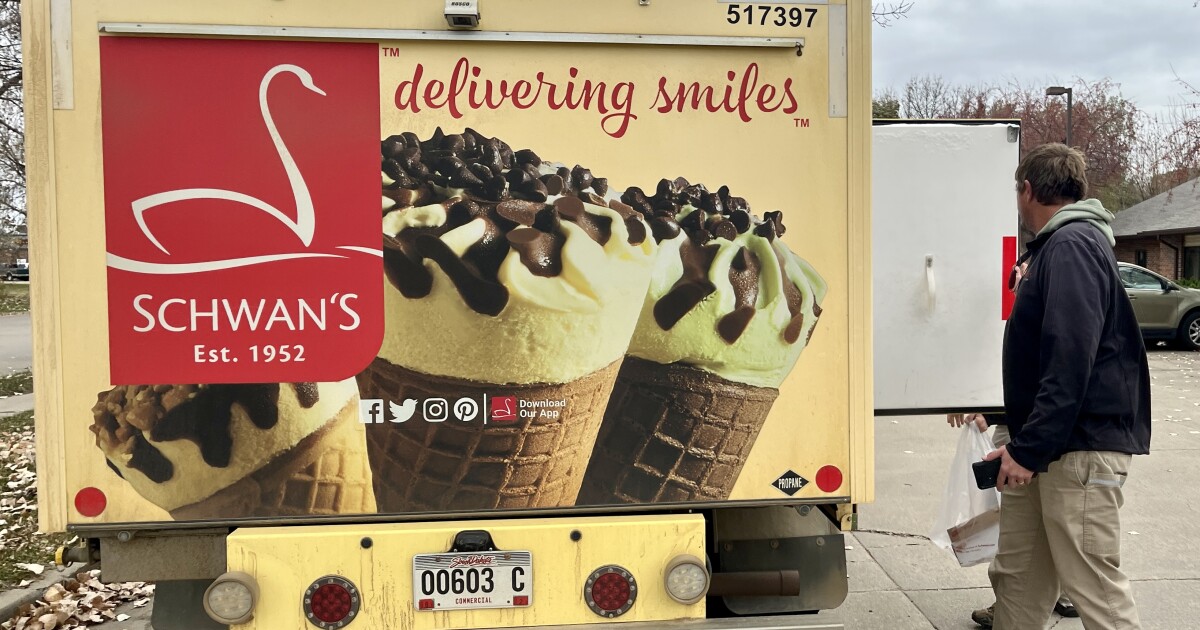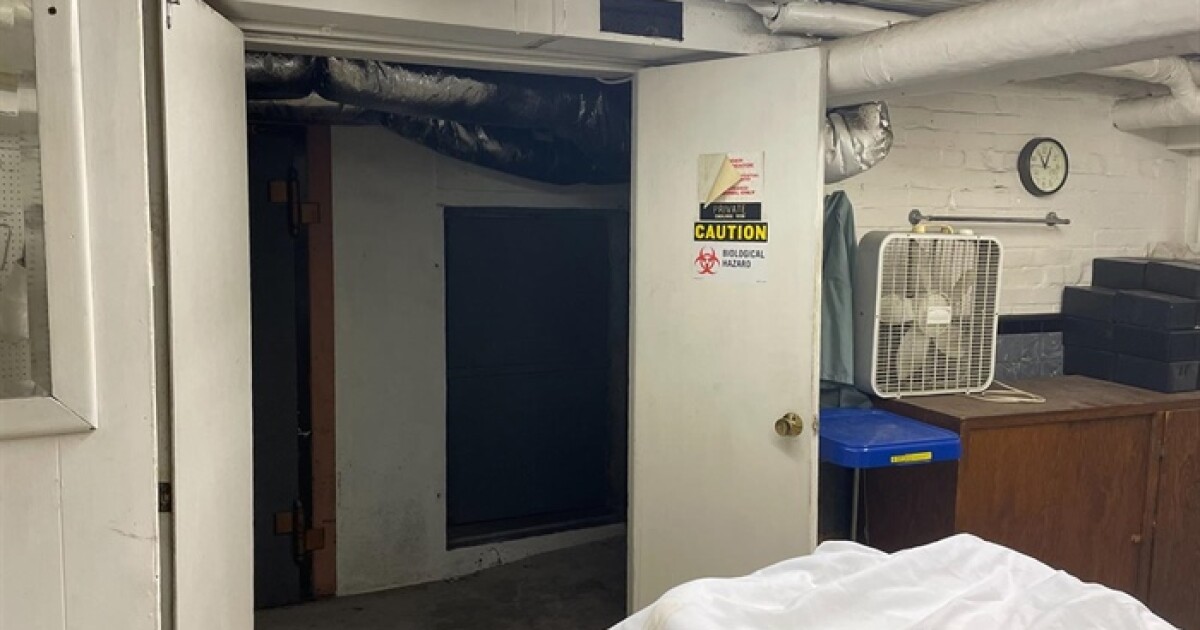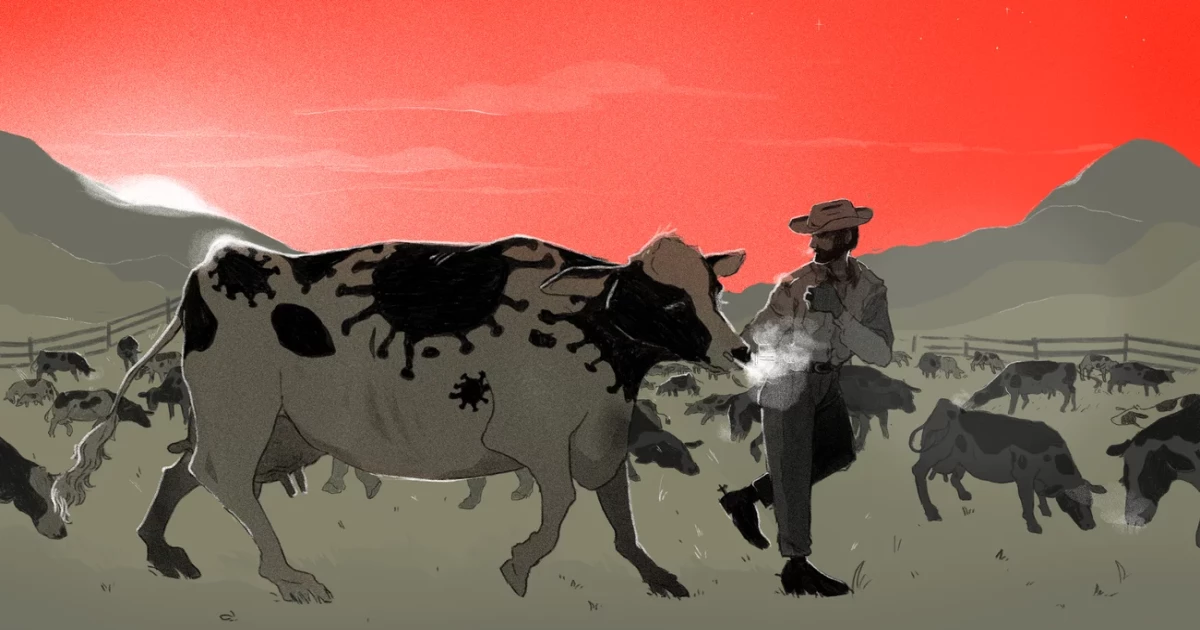Business
Schwan’s name change and layoffs challenge its legacy

Mary Bartels looks forward to seeing the yellow Schwan’s truck pull up outside her apartment building in Vermillion, South Dakota. She’s been getting frozen food deliveries – including ice cream, meat and meals — for nearly 60 years.The company’s customer service is at the heart of her loyalty.“It’s always been just unbelievable,” she said. “I trust them so much, I would hide a key outside for them if I wasn’t going to be home.”On this day, driver Nate O’Grady rings the doorbell and takes a seat at Mary’s kitchen table. As a child, the yellow trucks came to his grandparent’s house. Now he said getting to know the customers, kids and pets along his route is a highlight of his day.“You have much more connections with customers than with Amazon, where they ring your doorbell and leave. We have time to sit and talk with people,” O’Grady said.He knows what customers will order before they ask – for Mary, every order needs a box of peanut butter cup ice cream minis.
Elizabeth Rembert
/
Harvest Public MediaMary Bartels keeps her freezer stocked with peanut butter cup ice cream treats from Yelloh. She’s been ordering ice cream and other frozen food from Yelloh – previously Schwan’s – for nearly 60 years.
Schwan’s started in 1952, when a 23-year-old Marvin Schwan went door-to-door delivering 14 gallons of his family’s ice cream to homes in rural western Minnesota. Over the next 70 years, the company became beloved for its yellow trucks, friendly delivery people and frozen food.In 2018, South Korean food manufacturer CJ CheilJedang agreed to pay $1.8 billion for a majority stake in Schwan’s. The Schwan family spun off the home-delivery business and kept 100% ownership.Schwan’s Home Delivery changed its name to Yelloh in 2022 in an effort to appeal to a broader customer base in what is now a crowded food delivery space. The following year it cut 750 employees and closed around 90 delivery centers.Today, customers in all but 18 states rely on UPS to deliver their Yelloh frozen products, instead of the familiar yellow trucks.
Yelloh is contending with a much more competitive market. Danny Edsall – a co-leader for Deloitte’s global grocery practice – said the food space has gone through several phases of evolution in the last few decades.“Everyone got this idea that grocery is an incredibly important category,” he said. “And so there are a whole new wave of entrants chasing the grocery dollar.”Yelloh’s major competition was once local, family-owned markets. Now it’s facing big box stores like Walmart, Target and Costco. Amazon, Grubhub and others will even bring your groceries straight to your door.“I think we’re right in the heat of that battle, it’s yet to be decided who wins,” Edsall said. “The people who are doing it right are the ones who genuinely try and get to know their customer and tailor services to meet their customer’s needs.”It’s not unusual for a legacy company like Yelloh to shift strategies as it reckons with a more crowded market and changing customer preferences, Edsall said.“The art of retail is to reinvent yourself for a new consumer,” he said. “You always have to reinvent your brand while staying relevant. The companies who pull it off are the ones still around in 100 years.”
The company’s new name draws on its yellow trucks. “It’s not easy to build a new brand,” CEO Santana said. “But the food and the service is the same, and we will reinforce the new name with our customer base and attract new customers.”
From Schwan’s to YellohO’Grady, the delivery driver, said he’s seeing the new brand name Yelloh slowly catch on with his customers – but not with Mary.“They changed the name of it?” she asked O’Grady. “I didn’t know that; when did they do that?”The new name is inspired by customers’ memories of the yellow trucks, according to CEO Bernardo Santana.“It’s really common for us to hear ‘I remember when I was a child in my grandma’s house, seeing the yellow truck with the ice cream,’” he said. “The strongest brand we have is our yellow truck, so we wanted to bring back and keep this connection with our customers.”But Akshay Rao, a marketing professor at the University of Minnesota, is concerned that Yelloh’s new name moves away from a 70-year-old brand and confuses its devoted customers.“They may think ‘Who are these people? Are they the same friendly people with my ice cream?’” he said. “So Schwan’s had a monopoly that it has said, to the best of my understanding, goodbye to.”Rao said he hasn’t seen the company’s research, but he suspects Yelloh’s new rebranding and cuts are part of a strategic shift, emphasizing costs rather than customers. He said only time will tell if the move is successful, but he’s skeptical.“Schwan’s had an intimate relationship with its customers,” he said. “It’s now stepping back from that relationship, and customers are going to start looking at other options.”Deb Kuwamoto is one of those customers. The Lincoln, Nebraska resident can no longer receive deliveries straight from a Yelloh truck. She loved chatting with the delivery men and can name all her drivers going back 10 years.Now, Kuwamoto said she’ll just go to the grocery store instead of ordering from UPS.“It makes me a little sad,” she said. “I think it’s the end of an era. I miss the drivers.”
Marvin Schwan stands by the original branded truck in this picture from the 1950s. The Schwan’s company grew out of a drive on March 18, 1952, when Schwan packed a Dodge panel van with ice cream and delivered the tubs to families in rural Minnesota.
And she’s not fond of the new name. Kuwamoto said ordering from Schwan’s felt like stepping back into her childhood in rural Nebraska.“It’s really kind of ironic because Schwan’s was kind of like the first grocery delivery,” she said. “And now everybody has caught up to them.”Yelloh CEO Santana said customers are still the company’s priority, even as it scales back its delivery footprint.“We are trying to deliver for customers in an efficient way and keep up with all the changes in logistics. We didn’t have the internet when Schwan’s started,” he said. “And there’s all the changes in the market environment — 20 years ago, there was no Amazon. Now it’s this stronghold.”Plus, Santana said, some customers prefer a quick drop off over small talk with a driver.“Some people just ask, ‘Leave my product in a bag outside the door,’ and then others are happy to chat with our drivers,” he said. “It will take time, but we are building a new brand that can attract all of the customers we can get.”
Mary and Fritz Bartels celebrate their 40th anniversary in 1993 with their nine kids, grandchildren and Schwan’s ice cream. One of their daughters flagged down a driver and asked him to come to the celebration, saying, “My folks love Schwan’s and have ordered for years and years. Can you surprise them with a visit?”
60 years of Schwan’sBack in Mary’s apartment, she remembers when she started ordering from the company nearly six decades ago. Her nine kids would rush up the farmhouse driveway to meet the delivery man and climb all over his yellow truck.“They’d all come in with an ice cream bar or something. And now I realize he was giving those to the kids out of his pocket,” Mary said, “because I wasn’t paying for them.”At one point she was ordering to feed a family of 11, and she kept ordering from Schwan’s through her kids leaving for college, moving into town from the farm and her husband’s death.As she sits in her chair with her memories, driver Nate O’Grady checks her freezer for what she needs, grabs the peanut butter ice cream cups, fantail shrimp and chicken pot pies from his truck and packs them onto the freezer shelves. She’s done her grocery shopping without standing up.O’Grady tells her goodbye and climbs into his yellow truck idling outside of her apartment – still stamped with the Schwan’s logo.Editor’s note: Mary Bartels is the mother of the author’s stepdad.This story was produced in partnership with Harvest Public Media, a collaboration of public media newsrooms in the Midwest. It reports on food systems, agriculture and rural issues.
Business
New owner of vacated Centralia funeral home makes a startling find

In the basement of a Centralia funeral home in a dark hallway off the embalming room, tucked inside a nook behind two steel plates and a door, a visitor found three disembodied, neatly wrapped human legs, two of them marked with names and dated to the 1960s.The discovery stunned property owner Cindy Hansen, who had been cleaning up at the site of the former Moran Queen-Boggs funeral home for weeks. After all, she’d seen her last tenant evicted, his funeral director license suspended for the home’s filthy conditions – which included a dead rat in a stairwell.But as the shock dissipated on what first appeared to be a grisly find, a more mundane explanation materialized – the legs were likely the result of amputations, stored away decades ago until their owners died and they could be reunited and interred together, said Jay Boulanger, who has operated a funeral home in Highland for decades.“In those days, hospitals didn’t treat that as medical waste and cremation wasn’t popular then, so they just embalmed them and held on to them. Sometimes, people don’t get them, so they just stay,” Boulanger said.The discovery was made at the former funeral home operated by Hugh Moran in recent years, but he surrendered his license in March after state regulators found his facility in deplorable condition. But the hidden nature of the room and the fact that two of the legs were dated decades before Moran operated the facility indicate he was not involved in placing them there.Moran vacated the building last month, and Hansen began scrubbing and filling two large dumpsters with trash. After weeks of work, Hansen was seeing progress.Two casket salesmen came to pick up a display last week and asked her for a tour of the historic home with ornate oak woodwork and stained-glass windows, built by a cigar magnate in the late 1800s at the corner of South Elm and East Second streets in Centralia.On the tour, one salesman kept returning to that steel door in the dark hallway just off the embalming room.“Finally, he got a pair of pliers and turned the bolt to open it,” Hansen said. “There was another plate, so he opened that, too. Then, he got to the door and looked in. He backed up and said, ‘There’s legs in there.’”The three stood for a moment, then closed the door, returned the plates, and pondered what to do next.“I was completely freaked out,” Hansen said.But her shock at the situation did not raise any immediate response. She called the Illinois State Police, who called the Marion County coroner, who advised her to lock up when she left on May 7 and they would get back to her. The legs remained at the funeral home as of Tuesday, but the coroner said he will be getting them soon, Hansen said.In late February, three days after Capitol News Illinois sent questions to the department about an unanswered December 2023 complaint that the embalming room looked “like something from a scary, filthy, freak show,” the Illinois Department of Financial and Professional Regulation inspected the building.Inspectors didn’t disturb the steel plates blocking the nook with the legs, but they did find that Moran had maintained the embalming room in “extremely unsanitary conditions,” and he agreed to surrender his funeral director license permanently. Photographs of the room submitted with the complaint depicted a water leak, piles of dirty laundry and medical waste, along with the dead rodent.The conditions at Moran’s funeral home became public within months of a discovery that a Carlinville funeral home provided the wrong ashes to at least 80 families, spawning lawsuits and legislation.Sen. Doris Turner, D-Springfield, introduced legislation called “Reestablishing Integrity in Death Care Act” after that discovery resulted in at least nine exhumations, including five from Camp Butler National Cemetery in Springfield. No criminal charges have been filed against the funeral director responsible for those remains, August Heinz.Senate Bill 2643 codifies best practices already in place by most funeral homes, mandating that a unique identifier must be put on the deceased’s body and any other associated human remains. Under the proposal, a director must also document the chain of custody for all bodies and human remains.The bill also mandates that the state must respond to complaints within 10 days and gives authority to remedy the complaints, including inspecting the funeral home premises.That bill is awaiting a vote in the House.Clean-up at the former Moran-Boggs continues.But the name on the sign outside will soon change. Funeral Director Vonda Rosado will take over and change the name to Maxon-Rosado Funeral Home, the same as her other funeral home in DuQuoin. She plans to hire a professional to clean the embalming room.“We want to restore the history and integrity of this beautiful facility,” she said.Capitol News Illinois is a nonprofit, nonpartisan news service covering state government. It is distributed to hundreds of newspapers, radio and TV stations statewide. It is funded primarily by the Illinois Press Foundation and the Robert R. McCormick Foundation, along with major contributions from the Illinois Broadcasters Foundation and Southern Illinois Editorial Association.
Business
Illinois State Vet: Bird flu no threat to milk or food supplies

Two weeks after the U.S. Department of Agriculture implemented mandatory testing and reporting for interstate movement of dairy cattle in response to the spread of bird flu within the nation’s livestock sector, there are still no confirmed cases of the H5N1 influenza virus in Illinois.This is according to Illinois Department of Agriculture State Veterinarian Mark Ernst, who said dairy cattle producers were asked to implement safety protocols to prevent spreading the strain of highly pathogenic avian influenza [HPAI], whose presence has been detected in the nation’s milk supply.“H5N1 was first detected in livestock in Texas. The thought is that they were exposed to perhaps wild birds, which were able to transmit it over to cattle,” said Ernst, a Washington, Illinois, native who has served as state veterinarian for about the last 20 years. “In Illinois, we have not had any detections so far in our dairy herd. There are nine other states that have had detections on 36 premises.”There have been no confirmed U.S. detections of H5N1 in livestock reported since the USDA issued the mandatory testing and reporting protocol in late April, said Ernst, adding mortality rates among infected livestock have been low to non-existent.“It seems the cows recover over a period of time, though it may take upwards of a month,” said Ernst. “They do come back in their milk; however they don’t appear to be milking at a level where they were before they became infected.”
Illinois Department of Agriculture State Veterinarian Mark Ernst.
Illinois milk producers have been stepping up their biosecurity measures and limiting farm visitors since the H5N1 outbreak gained momentum several weeks ago while monitoring for telltale signs of the virus in their cattle.According to guidance issued to dairy cow producers on Tuesday, the USDA mandates that producers report animals with the following clinical signs to their state veterinarian immediately: decreased herd level milk production; acute sudden drop in production with some severely impacted cows experiencing thicker, concentrated, colostrum‐like milk; decrease in feed consumption and lethargy, dehydration and fever, among other symptoms.However, some cattle may present asymptomatically yet still harbor the H5N1 virus.“You’ve got to be really careful right now introducing new stock to the herd. It would be advisable to isolate incoming animals,” said Ernst. “The other thing that applies to more than just H5N1 is good biosecurity. You’ve got to limit farm traffic to essential traffic, and have good disinfectant cleaning of equipment and buildings. You also must limit the access of wildlife to feed sources and water sources.”Scientists are working to discover the pathway the virus takes in infecting cow milk. Reuters reports scientists suspect the virus can spread between cattle during the milking process, either through contact with infected equipment or with a virus that becomes aerosolized during cleaning procedures.“For whatever reason, the virus has had an affinity, more or less, for the udder and for milk,” Ernst said. ‘Fortunately, pasteurization has shown so far to be effective at destroying the virus in milk. The consumption of pasteurized dairy products doesn’t seem to be a risk at all to the public.”An IDOA news release noted the U.S. Food and Drug Administration has announced the commercial milk supply is believed safe due to the pasteurization process that destroys bacteria and viruses in milk. Protocols also are in place to destroy milk from affected dairy animals, according to Illinois Department of Public Health Director Dr. Sameer Vohra.“IDPH prioritizes the safety of our milk supply as well as the Illinoisans who work with cattle and poultry,” said Vohra. “Please note that pasteurized milk is safe, but we strongly recommend that Illinoisans avoid any unpasteurized raw milk products at this time based on the potential risk of infection.”The virus seems to be contained exclusively to dairy cattle at this point, Ernst observed. “At this point in time, there have been no reports of the virus in beef cattle. That could change; this is evolving and we’ve got to be vigilant.”Though the risk to livestock and the nation’s milk and food supplies may be nominal, the Center for Disease Control reported on Wednesday that the first case of human H5N1 infection has been confirmed in a Texas dairy worker.While the current public health risk is low, the CDC is watching the situation carefully and working with states to monitor people with animal exposure. In addition, the CDC is also beginning to monitor wastewater for signs of the virus and will issue a public report soon.Illinois is home to more than 600 dairy farms with 73,000 cows or calves, according to the USDA National Agricultural Statistics Service.
Business
University City entrepreneurs bake for college and a cause
For veteran bakers and baking novices alike, perfecting the classic chocolate chip cookie is no simple feat. The perfect bite is a confluence of textures, an artful balance between salty and sweet and slightly bitter, all of which come to fruition with quality ingredients and impeccable technique.Maya, 11, and Nadia Turner, 13, have not only come to the perfect recipe, but are sharing their confections with loyal customers. The University City sisters are the founders of Chocolate Girls’ Cookies and have been selling cookies since 2019.
Chocolate Girls’ Cookies signature chocolate chip cookie. The sisters
The Turners were inspired to form the LLC after seeing kids their age on TV.“I really wanted to be different,” said Maya. “There were no kids at my school who had their own business and I wanted to be the first. We watched Shark Tank and we saw kids on there and I was like, ‘I want to be in Shark Tank.’”The cookie company was also born out of the girls’ love for baking at an early age. Their mother, Shelly Williams, would bake cookies for Maya and Nadia when they were little. Over time, the girls adapted their great-great-grandmother’s recipe, found willing taste testers, and tweaked the recipe based on the feedback they received.“We thought we had something just based on the taste and the feedback that we had,” said Michael Turner, Nadia and Maya’s father and Chocolate Girls’ Cookies’ manager. “We passed out cookies at my job — I had a Ziploc bag [of cookies] — and a guy cupped his hands and asked for the crumbs. That’s when I was like, ‘Girls, we’re really onto something.’”
Maya and Nadia with their father and Chocolate Girls’ Cookies’ manager, Michael Turner. After overwhelmingly positive feedback from his coworkers on the girls’ cookies, Turner realized Maya and Nadia had a promising future in the cookie business.
Proceeds from selling the sweet treats go toward Maya and Nadia’s college fund. Some of the earnings are also set aside for a cause that’s important to the family. The girls’ merch features their company name with cookies in place of O’s and a pink ribbon as the L in “chocolate.”“Our grandmother passed away from breast cancer awareness, so we put [the ribbon] in our hoodie,” said Nadia, who came up with the design. “We donate some [of the] money to breast cancer awareness.”Previously, Chocolate Girls’ Cookies desserts were sold at the Soulard Farmers Market and at St. Louis Children’s Hospital. Now you can find their cookies in select movie theaters, Barnes Jewish Hospital and on their website: www.chocolategirlscookies.com.To learn more about what makes a good chocolate chip cookie, the girls’ aspirations for their business and how they feel about sour cream as a cookie dough ingredient, listen to St. Louis on the Air on Apple Podcast, Spotify or Google Podcast, or by clicking the play button below.
Young University City entrepreneurs bake cookies for college and breast cancer awareness
“St. Louis on the Air” brings you the stories of St. Louis and the people who live, work and create in our region. The show is produced by Ulaa Kuziez, Miya Norfleet, Emily Woodbury, Danny Wicentowski, Elaine Cha and Alex Heuer. Roshae Hemmings is our production assistant. The audio engineer is Aaron Doerr.
-

 Entertainment1 year ago
Entertainment1 year agoSt.Louis Man Sounds Just Like Whitley Hewsten, Plans on Performing At The Shayfitz Arena.
-

 Business1 year ago
Business1 year agoWe Live Here Auténtico! | The Hispanic Chamber | Community and Connection Central
-
Board Bills1 year ago
2022-2023 Board Bill 189 — Public Works and Improvement Program at the Airport
-

 Local News1 year ago
Local News1 year agoVIDEO: St. Louis Visitor Has Meltdown on TikTok Over Gunshots
-

 News1 year ago
News1 year agoTed Lasso-inspired pop-up bar now open in St. Louis
-

 Board Bills1 year ago
Board Bills1 year ago2022-2023 Board Bill 165 — Jefferson Arms Community Improvement District
-
Board Bills1 year ago
2022-2023 Board Bill 183 — Amending Ordinance Number 62885 known as the Capital Improvements Sales Tax
-

 News10 months ago
News10 months agoGas tanker crashes into St. Louis Metro transit center





